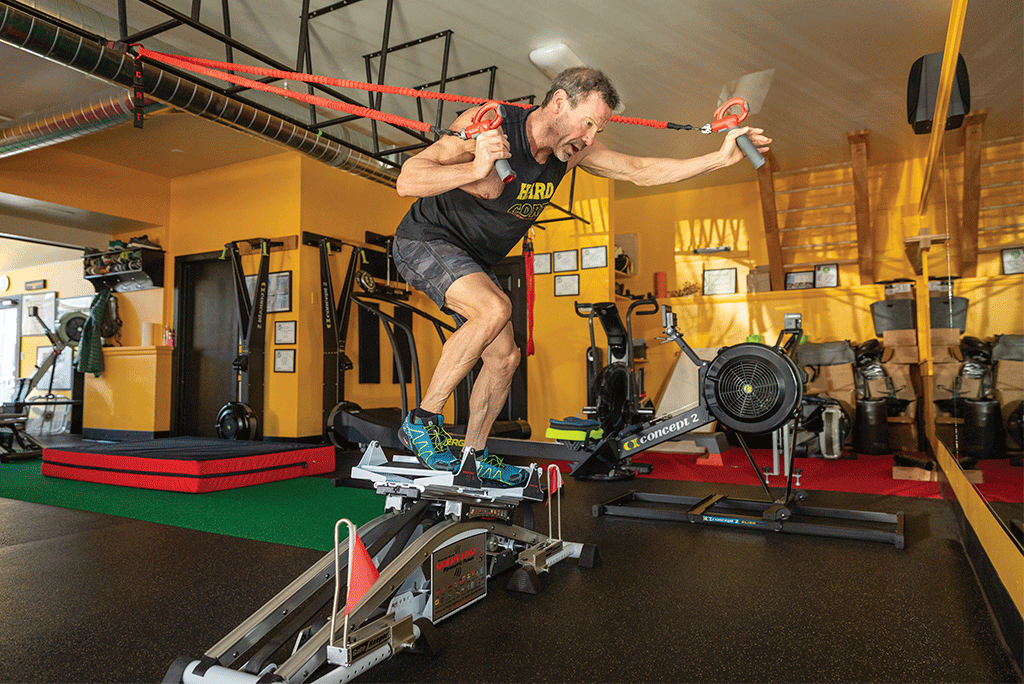What’s not to love about hurtling down a mountain on fat skis faster than a speeding cheetah or losing yourself deep in the woods on skinny skis … only to find yourself there too. What started thousands of years ago with our Cro-Magnon ancestors attaching sticks to their feet has evolved into two of the most popular winter sports, with over 6,000 resorts worldwide accommodating millions of skiers every year.
While it’s safe to say a lot has changed—especially with regard to equipment (“ski” comes from the Old Norse word skio, which means “stick of wood”)—there’s a lot that hasn’t changed; like outlier athletes who loathe conventional wisdom, train “out of the box,” and consistently find ways to win. Let’s get started with 50 years of dry-land training for Nordic skiing’s younger, adrenaline-addicted sibling, alpine skiing!
One thing both Nordic and alpine skiing share—which is different from any other sport– is they take place on a playing field whose physical properties are subject to constant change. During the course of sliding down thousands of vertical feet of water that may morph from solid to liquid, to vapor (or even exist in all three states at the same time, which is the speedy triple point at 32 degrees Fahrenheit), alpine skiers need to make constant adjustments to maintain the highest velocity, and not crash.
Go fast. Make adjustments. Don’t crash. These three “simple” tenets are at the heart of training programs for one of the planet’s most technically complex and physically demanding sports. Coincidentally, while alpine skiing was making its debut in 1936 as an Olympic event in Germany, it was also being introduced to recreational skiers with the world’s very first chairlifts in Sun Valley, Idaho.
Turning the clock back 50 years to the halcyon days of the ’70s, you’d find alpine Olympian and longtime local Mike Lafferty training with the U.S. Ski Team for the downhill World Cup circuit. Lafferty described the off-snow training back then
as “prehistoric.”
“We did quite a bit of hiking, played soccer, and lifted weights once or twice per week. Nothing particularly organized or sophisticated,” Lafferty said.
Although Mike was able to essentially ski himself into good enough shape to earn a third-place finish in the World Cup downhill overall standings in 1972—which was the best by an American male until 2003, when Daron Rahlves finished second—he considers himself lucky to have skied nearly as fast as today’s downhill skiers, without missing a single race from knee injuries. According to Mike, who is now 75 but still flies down Baldy like a teenage peregrine falcon, his luck had less to do with being the strongest guy on the hill and more to do with using the “primitive” equipment back then, which wouldn’t allow you to “hook up” in a ski turn nearly as aggressively as with today’s best gear.
It turns out that the “bad luck” of many of today’s top alpine skiers—who frequently find themselves undergoing multiple surgeries from blown-out knees or broken bones—may have a lot more to do with improved snow preparation resulting in harder, faster surfaces, and advances in equipment design (the introduction of carving skis in World Cup racing in 1999 forever changed turns), than lack of physical preparation. Today’s top alpine skiers are taller, heavier, and significantly stronger than their predecessors. They need to be because studies demonstrate peak Ground Reaction Force, a common measure of the external load on the skier and equipment, can be as high as five times body weight in slalom races and three times body weight in the other disciplines.
Training top-tier skiers to overcome the extreme isometric and eccentric forces of high-speed turns typically involves high-speed eccentric work such as box jumps, supra-maximal eccentric training (lowering a weight that’s too heavy to lift)—which, of course, Bode Miller built his own device—or a special/evil cycle ergometer designed by Swiss sport scientists which forces the athlete to eccentrically “brake” the machine; lest you find your kneecap in your nose. A word to the wise recreational skier: earning great eccentric power comes with even greater responsibility. Heavy and/or fast eccentric (muscle lengthening under tension) loading is dangerous, particularly for older bodies, which lose pliability, elasticity, and muscle mass as part of the aging process. The best advice is to seek professional help before engaging in this type of training.
In addition to high levels of peak force and eccentric strength, elite alpine skiers also benefit from having a “big engine” to deliver oxygen to the working muscles for 45-120 seconds. To build a bigger aerobic engine and limit lactic acid accumulation, many of the best skiers consistently perform high-intensity interval training on the AirBike and C2 Row/Ski Ergometers, as well as cross-train in other sports such as cycling, hockey, kayaking and rollerblading. Lindsay Vonn, winner of 82 World Cup races, was known for not only spending six hours per day in the gym (off-season) but also cycling 2-3 hours per day, which, according to her private trainer, Alex Bunt, “gave her the fitness to continually perform for five months on the hill.”
As every alpine skier figures out pretty quickly, to ski fast and avoid being force-fed a high-velocity snow cone, you need much more than just high levels of strength and aerobic fitness. You need a plethora of dynamic balance and agility to continuously compensate for high-speed internal and external forces. Aggressive agility drills, coupled with unilateral and bilateral training on unstable surfaces, are paramount for skiers of all levels. Bode Miller relied heavily on the slack line for unstable squats and isometric holds, while Mikaela Shiffrin and many of today’s top skiers consistently perform dozens of different stabilization exercises on the BOSU ball.
Last but definitely not least is mobility, core, and upper-body training. As far as “stretching” goes to improve joint range of motion, there’s a lot of science behind the functional benefits of dynamic flexibility training vs. “static” stretching. This is why most top skiers perform daily swinging-type exercises for the core and extremities. Dynamic mobility training also works best before skis on snow and may improve performance.
Core strength and stability training is an integral part of an alpine skier’s dry land program, generally consisting of a wide variety of both static and dynamic exercises to build intelligence in the spinal stabilization system, integrity in the joints and connective tissue, and muscle power capable of producing the torque and massive counter-torque necessary to negotiate high-speed turns.
What’s the upper body got to do with alpine skiing? Aside from being the direct link to poles and counterbalancing centrifugal force like a mountain lion’s tail, alpine skiers need strength and mobility in the upper body joints and muscles to withstand the forces associated with the inevitable crash. While the vast majority of the roughly 600,000 annual ski and rider injuries in the U.S. are knee-related, up to 11% of those (approximately 60,000 injuries) are shoulder-related, and 20 percent are head injuries (wear your helmet!). Today’s best skiers use various loading modalities and multi-dimensional exercises to bulletproof the upper body from crash-related blunt force trauma.
In case you haven’t noticed, training for alpine skiing is fundamentally complex. And for every complex problem, there is a simple, clear, and plausible solution that is wrong. The wrong solution for ski training can lead to injuries, both on and off the hill. The right solution for older recreational skiers should be based not so much on what the best 20-year-old Olympians are doing but on a highly personalized and holistic science-based methodology that takes into account performance goals, exercise and injury history, age, and current fitness level, including balance, coordination, and strength. Reach out if you need help training to ski fast, make adjustments, and not crash.
When it comes to Nordic skiing, think again if you need to practice planks and throw heavy weights around. Studies have demonstrated that improving isometric strength from planks does not correlate well with improving speed for XC skiing, nor does one rep max upper and lower body strength training. What does correlate well with XC ski performance is ski-specific dynamic power training in all 6-dimensions of movement (up/down, lateral, front/back, forward-bend, side-bend, rotary). The Concept2 SkiERG is the gold standard for training dynamic 6-D movements indoors and objectively measuring power output to see how you stack up against the best athletes in the World.
Best advice for Nordic skiers looking to get better without getting hurt:
- Skip the planks, high-risk roller-skiing and heavy weights.
- Focus on overloading multidimensional movements—similar to xc skiing—utilizing elastic resistance, air resistance from ergometers, and body-weight-leveraged resistance.
- Do daily bouts of dynamic flexibility training.
- Perform thrice weekly unilateral balance and plyometric training.
- Incorporate high-intensity intervals on the SkiERG, Schwinn AirDyne, and RowERG 3-5x/week to build the total-body power endurance necessary to ski insanely fast while smiling like a two-year-old on Christmas morning.
Bill Nurge has been a world-class strength and conditioning trainer for over four decades, who specializes in winter sports, rowing, and taking older athletes to new levels of fitness and performance. He’s also had his fair share of athletic accomplishments including a 10th place finish at the 1992 Olympic Trials for Biathlon, silver medal at the U.S. Summer Biathlon National Championships, and 46 world records on the Concept2 Ski and RowERGs.


